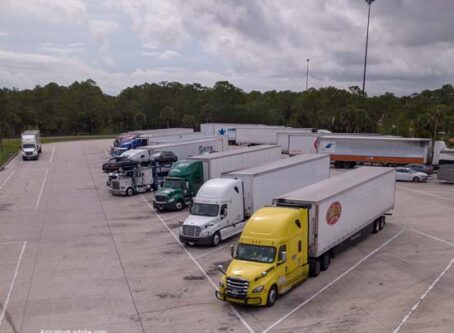July 1 is start date of rules on topics that include idling and left lane use
Truckers must be on constant watch for new rules that could affect them as they drive from point A to point B. Fresh off legislative action in states around the country, July is one of the leading months for new laws to take effect. New laws on the books in multiple states cover topics that include truck idling, tort reform and left lane use.
Connecticut
The first of the month marks the onset of a new Connecticut law that gives cities and towns access to automatic cameras to ticket loud vehicles.
Communities across the state have ordinances against loud, modified exhaust pipes. Supporters said the ordinances, however, are difficult to enforce.
Gov. Ned Lamont acted earlier this month to sign into law a 258-page bonding bill that included a provision to permit localities to use “photo noise violation monitoring devices” to record vehicle noise in excess of 80 decibels. State approval for the devices is not needed.
Offending vehicle owners will initially receive a written warning. Repeat offenders will be mailed $100 violations. Additional violations will result in escalating fine amounts.
Critics, including the National Motorist Association, said the technology is “imperfect” and that the devices are unable to distinguish between vehicles that have modified mufflers and vehicles that simply need a muffler repair.
An appeal process is included in state law for vehicle owners to contest a ticket.
The state already permits the use of red-light cameras. Speed cameras are permitted in work zones.
Idaho
In Idaho, a new law in effect July 1 permits commercial vehicles to idle in certain circumstances.
The new rule allows a commercial vehicle to idle for the purposes of using its heating or air conditioning system when a driver is resting.
Another provision permits vehicle idling when parked for purposes of refrigerating perishable commodities, pharmaceuticals or both.
Idling is not allowed in residential areas.
The Idaho Trucking Association supported the rule change. ITA President and CEO Allen Hodges told lawmakers the change will help prevent rejection of pharmaceuticals or food due to trailer shutdowns, particularly in extreme weather conditions.
He added that the rule is necessary to supersede local idling ordinances throughout the state.
Indiana
A new Indiana law allows seat belt usage to be considered in accident lawsuits.
State law has prohibited the seat belt information from being made available to juries.
Gov. Eric Holcomb signed into law a rule to permit juries in civil lawsuits related to vehicle accidents to hear whether the victim was wearing a seat belt. That information can then be used when considering damages.
A judge still will have the final say whether the information is allowed to be presented.
Supporters said juries should be able to know whether injuries were worse because an adult did not wear a seat belt.
House Roads and Transportation Committee Chair Jim Pressel, R-Rolling Prairie, said it is important that the state not stand in the way of juries’ access to information about whether a vehicle occupant was wearing a seat belt.
“It has nothing to do with fault. It has nothing to do with cause. It’s only to be used in damages,” Pressel told lawmakers.
The American Trucking Associations said reforms like the new Indiana law are critical to ensuring fairness and balance in the civil justice system.
“This is a commonsense measure that only increases transparency and ensures jurors have complete information when rendering a fair and just verdict,” ATA President Chris Spear said in previous remarks.
Kentucky
As of July 1, a new Kentucky law singles out trucks from travel in the far-left lane of certain highways.
State law requires vehicles traveling below the posted speed limit on any limited-access highway with a posted speed limit of at least 65 mph to stay to the right. Exceptions are made for passing, for yielding to traffic entering the highway or for when it’s unsafe to use the right lane.
The new law takes the extra step of prohibiting a truck tractor, trailer or semitrailer from accessing the far-left lane. The rule applies on highways with at least three lanes traveling in the same direction.
Exceptions are made for entering or leaving a highway, for yielding to traffic coming onto the highway or for when traffic conditions exist that would prohibit safe use of the right or center lanes.
Professional drivers have concerns about the new law.
The OOIDA Foundation reported that research has demonstrated truck lane restrictions are difficult to enforce, accelerate pavement deterioration, create speed differentials and increase merging conflicts and crashes.
Utah
Starting July 1 in Utah, a new law addresses road rage on state roadways.
The new law creates a definition for road rage in statute. The rule defines “road rage events” as a criminal offense by an operator of a vehicle in response to an incident that occurs or escalates upon a roadway with the intent to endanger or intimidate an individual in another vehicle.
Any crime committed is permitted to be categorized as road rage with additional penalties.
In addition to minimum $750 fines and possible prison time, police will have the option to seize and take possession of a vehicle without a warrant when there is probable cause to believe the vehicle was involved in a road rage event. The impound fee for any car, truck, truck tractor, bus or other vehicle will be $400.
A judge also will have the option to suspend the offender’s driver’s license. Multiple offenses within 12 months would result in a mandatory revocation.
Fines related to offenses will be used to help fund a road rage education campaign.
Sen. Todd Weiler, R-Woods Cross, said the new law is not about punishing someone for showing their middle finger.
“We’re not talking about someone flipping someone off. We’re talking about a criminal offense, and you’re trying to endanger or intimidate another individual,” Weiler told Senate lawmakers. LL









